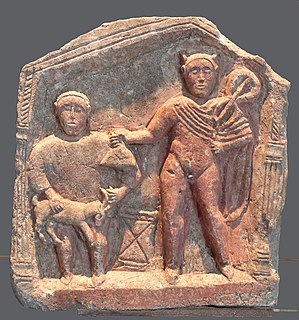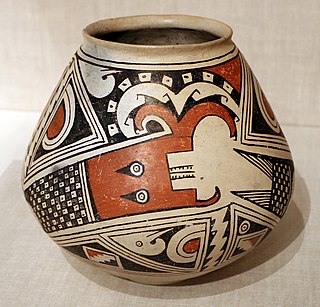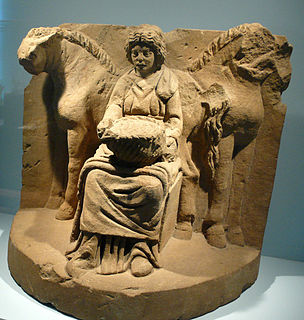
Cernunnos is the conventional name given in Celtic studies to depictions of the "horned god" of Celtic polytheism. Cernunnos was a Celtic god of fertility, life, animals, wealth, and the underworld. The name itself is only attested once, on the 1st-century Pillar of the Boatmen, but he appears all over Gaul, and among the Celtiberians. Cernunnos is depicted with the antlers of a stag, seated cross-legged, associated with animals, and holding or wearing torcs. This deity is known from over 50 examples in the Gallo-Roman period, mostly in north-eastern Gaul.

Mercury is a major god in Roman religion and mythology, being one of the 12 Dii Consentes within the ancient Roman pantheon. He is the god of financial gain, commerce, eloquence, messages, communication, travelers, boundaries, luck, trickery and thieves; he also serves as the guide of souls to the underworld. He was considered the son of Maia, who was a daughter of the Titan Atlas, and Jupiter in Roman mythology. His name is possibly related to the Latin word merx, mercari, and merces (wages); another possible connection is the Proto-Indo-European root merĝ- for "boundary, border" and Greek οὖρος, as the "keeper of boundaries," referring to his role as bridge between the upper and lower worlds. In his earliest forms, he appears to have been related to the Etruscan deity Turms; both gods share characteristics with the Greek god Hermes. He is often depicted holding the caduceus in his left hand. Similar to his Greek equivalent Hermes, he was awarded the caduceus by Apollo who handed him a magic wand, which later turned into the caduceus.

Plutus is the Greek god of wealth. He is either the son of Demeter and Iasion, with whom she lay in a thrice-ploughed field; or the child of Pluto and Persephone. In the theology of the Eleusinian Mysteries he is regarded as the "Divine Child."

In ancient Roman religion, Abundantia was a divine personification of abundance and prosperity. She was among the embodiments of virtues in religious propaganda that cast the emperor as the ensurer of "Golden Age" conditions. Abundantia thus figures in art, cult, and literature, but has little mythology as such. She may have survived in some form in Roman Gaul and medieval France.

In Gallo-Roman religion, Rosmerta was a goddess of fertility and abundance, her attributes being those of plenty such as the cornucopia. Rosmerta is attested by statues, and by inscriptions. In Gaul she was often depicted with the Roman god Mercury as her consort, but is sometimes found independently.

In Irish mythology, Nuada or Nuadu, known by the epithet Airgetlám, was the first king of the Tuatha Dé Danann. He is also known as Nechtan, Nuadu Necht and Elcmar, and is the husband of Boann. He is thought to have been a god and is related to the British and Gaulish god Nodens, who is associated with hunting and fishing. His Welsh equivalent is Nudd or Lludd Llaw Eraint.
In Celtic mythology, Condatis was a deity worshipped primarily in northern Britain but also in Gaul. He was associated with the confluences of rivers, in particular the River Wear which runs its course largely within County Durham. Condatis is known from several inscriptions in Britain and a single inscription found at Alonnes, Sarthe, France. In each case he is equated with the Roman god Mars.

Nodens is a Celtic deity associated with healing, the sea, hunting and dogs. He was worshipped in ancient Britain, most notably in a temple complex at Lydney Park in Gloucestershire, and possibly also in Gaul. He is equated with the Roman gods Mars, Neptune and Silvanus, and his name is cognate with that of the Irish mythological figure Nuada and the Welsh Nudd.
In ancient Celtic religion, Rudianos was a war god worshiped in Gaul. In Roman times he was equated with Mars.

In Gallo-Roman religion, Smertrios or Smertrius was a god of war worshipped in Gaul and Noricum. In Roman times he was equated with Mars. His name contains the same root as that of the goddess Rosmerta and may mean "The Purveyor" or "The Provider", a title rather than a true name. Smertulitanus may be a variant name for the same god.
In Romano-British culture and Germanic polytheism, the Alaisiagae were a pair of Celtic and Germanic goddesses deifying victory.

The Horned Serpent appears in the mythologies of many Native Americans. Details vary among tribes, with many of the stories associating the mystical figure with water, rain, lightning and thunder. Horned Serpents were major components of the Southeastern Ceremonial Complex of North American prehistory.
Lusitanian mythology is the mythology of the Lusitanians, the Indo-European people of western Iberia, in the territory comprising most of modern Portugal, Galicia, Extremadura and a small part of Salamanca.

Mullo is a Celtic god. He is known from inscriptions and is associated with the god Mars in the form of Mars Mullo.
Mars Iovantucarus was a Celtic god who was associated with the Treveran healer-god Lenus Mars at his sanctuary at Trier. The name reflects the deity's function as a protector of youth, and the temple was visited by pilgrims who often brought with them images of children, often depicting as holding pet birds as offerings to the god. At Tholey, also in Treveran territory, ‘Iovantucarus’ was also used as an epithet of Mercury.
Bergusia is a Celtic goddess, consort of the god Ucuetis, and worshipped with him at Alesia in Burgundy. The divine couple are named on inscriptions of the Romano-Celtic period, and an image of a divine couple has been found on the same site, the male figure bearing a hammer, the female appearing as a goddess of prosperity. This image, if it is indeed of the two deities, may indicate that Ucuetis was a patron god of craftsmen. This may be confirmed by the discovery of an epigraphic dedication to the couple, inscribed on a bronze vase and found in the cellar of a huge building: rubbish found in this underground room was made of entirely of scraps of bronze and iron and appears to have been part of the stock of metalsmiths. It is possible that this room was a sanctuary to the local crafts-deities of Alesia, and the superstructure itself may have a craft hall for metalworkers.
Toutatis or Teutates is a Celtic god who was worshipped in ancient Gaul and Britain. On the basis of his name's etymology, he has been widely interpreted to be a tribal protector.

In ancient Roman religion and myth, Mars was the god of war and also an agricultural guardian, a combination characteristic of early Rome. He was second in importance only to Jupiter and he was the most prominent of the military gods in the religion of the Roman army. Most of his festivals were held in March, the month named for him, and in October, which began the season for military campaigning and ended the season for farming.

The gods and goddesses of the pre-Christian Celtic peoples are known from a variety of sources, including ancient places of worship, statues, engravings, cult objects and place or personal names. The ancient Celts appear to have had a pantheon of deities comparable to others in Indo-European religion, each linked to aspects of life and the natural world. By a process of synthesism, after the Roman conquest of Celtic areas, these became associated with their Roman equivalent, and their worship continued until Christianization. Ancient Celtic art produced few images of deities, and these are hard to identify, lacking inscriptions, but in the post-conquest period many more images were made, some with inscriptions naming the deity. Most of the specific information we have therefore comes from Latin writers and the archaeology of the post-conquest period. More tentatively, links can be made between ancient Celtic deities and figures in early medieval Irish and Welsh literature, although all this was produced well after Christianization.

Celtic mythology is the mythology of Celtic polytheism, the religion of the Iron Age Celts. Like other Iron Age Europeans, the early Celts maintained a polytheistic mythology and religious structure. For Celts in close contact with Ancient Rome, such as the Gauls and Celtiberians, their mythology did not survive the Roman Empire, their subsequent conversion to Christianity and the loss of their Celtic languages. It is mostly through contemporary Roman and Christian sources that their mythology has been preserved. The Celtic peoples who maintained either political or linguistic identities left vestigial remnants of their ancestral mythologies that were put into written form during the Middle Ages.
Dictionary of Celtic Myth and Legend. Miranda Green. Thames and Hudson Ltd. London. 1997













